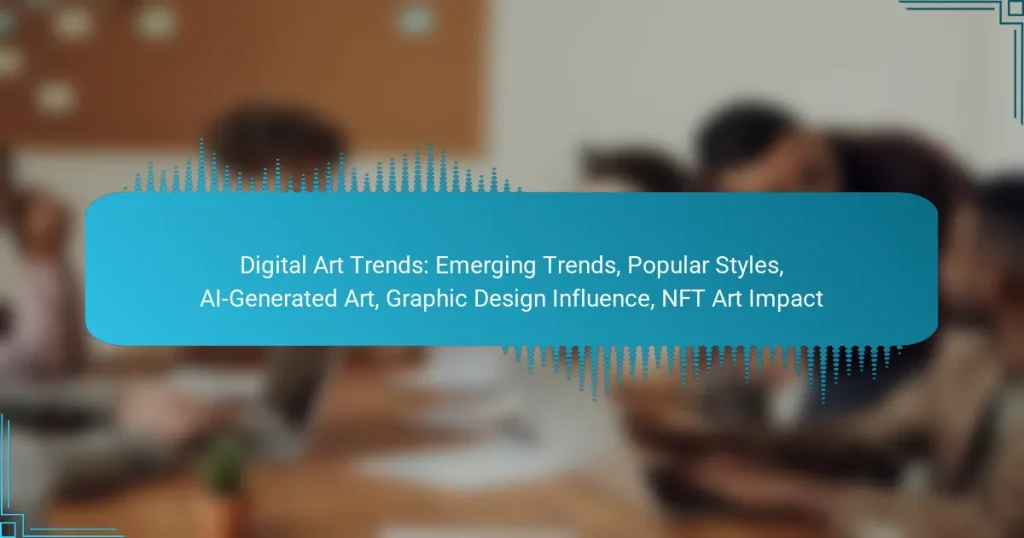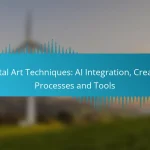In 2023, digital art trends are characterized by a fusion of technology and creativity, emphasizing interactive experiences and sustainability. The rise of AI-generated art is reshaping artistic expression, allowing for innovative styles while prompting discussions about originality and authorship. As artists embrace new mediums and techniques, the landscape of digital art continues to evolve, reflecting diverse aesthetics that resonate with contemporary audiences.
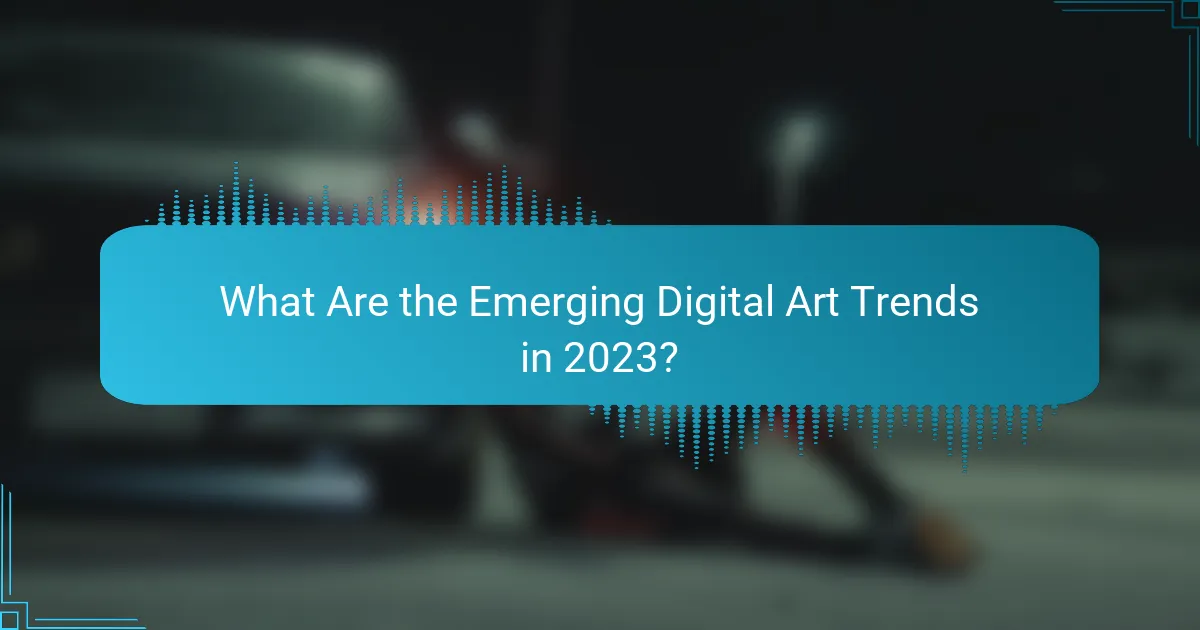
What Are the Emerging Digital Art Trends in 2023?
Emerging digital art trends in 2023 reflect a blend of technology and creativity, with a focus on interactive experiences, sustainability, and the integration of artificial intelligence. Artists are exploring new mediums and tools, leading to innovative styles and practices that resonate with contemporary audiences.
Increased Use of Augmented Reality
Augmented reality (AR) is becoming a prominent tool in digital art, allowing artists to create immersive experiences that blend the physical and digital worlds. This technology enables viewers to interact with art pieces through their smartphones or AR glasses, enhancing engagement and accessibility.
For example, artists can overlay digital images onto real-world environments, transforming public spaces into interactive galleries. As AR technology becomes more user-friendly, expect to see more artists experimenting with this medium to reach wider audiences.
Integration of AI Tools in Creation
Artificial intelligence is increasingly influencing the creation of digital art, with tools that assist artists in generating unique visuals and concepts. AI can analyze vast datasets to inspire new styles or automate repetitive tasks, allowing artists to focus on their creative vision.
Artists are using AI algorithms to create everything from abstract designs to realistic portraits. However, it’s essential to balance AI’s capabilities with personal creativity to maintain authenticity in the artwork.
Focus on Sustainability in Art
Sustainability is becoming a key consideration in digital art, with artists seeking eco-friendly practices and materials. This trend is driven by a growing awareness of environmental issues and the desire to create art that reflects social responsibility.
Digital artists can adopt sustainable practices by using energy-efficient technologies and promoting digital formats that reduce waste. Collaborations with organizations focused on environmental conservation are also becoming common, further integrating sustainability into the art community.
Rise of Interactive Art Experiences
Interactive art experiences are gaining popularity, as they invite viewers to engage with the artwork actively. This trend emphasizes participation, often incorporating elements like touch, movement, or sound to create a more immersive experience.
Exhibitions that allow audience interaction can enhance emotional connections to the art. Artists are encouraged to think creatively about how to involve their audience, whether through digital installations or online platforms that foster community engagement.
Popularity of 3D Art and Animation
3D art and animation are seeing a surge in popularity, driven by advancements in technology and software. Artists are utilizing 3D modeling tools to create dynamic visuals that can be used in various applications, from video games to virtual reality.
This trend allows for greater depth and realism in digital art, appealing to audiences who appreciate intricate designs. Artists should consider exploring 3D software options to expand their creative toolkit and meet the growing demand for animated content.

How Is AI-Generated Art Shaping the Industry?
AI-generated art is transforming the creative landscape by enabling artists to explore new styles and techniques while streamlining the creative process. This technology not only enhances artistic expression but also raises questions about originality and authorship in the art world.
AI as a Creative Partner
AI serves as a creative partner by assisting artists in generating ideas, compositions, and even entire artworks. Tools like generative adversarial networks (GANs) allow artists to input parameters and receive unique outputs, fostering collaboration between human creativity and machine learning. This partnership can lead to innovative styles that blend traditional techniques with modern technology.
For instance, artists can use AI to create variations of their work, experiment with color palettes, or generate concepts that they might not have considered. This not only saves time but also opens up a wider range of creative possibilities.
Impact on Traditional Art Forms
The rise of AI-generated art is influencing traditional art forms by challenging the definition of what constitutes art. As AI tools become more prevalent, traditional artists may incorporate these technologies into their practices, leading to hybrid forms that combine human and machine input. This shift can enhance the accessibility of art creation, allowing more people to engage with artistic processes.
However, this integration can also provoke resistance from purists who believe that art should stem solely from human experience. The dialogue between traditional and AI-generated art continues to evolve, reflecting broader societal changes in how we perceive creativity.
Ethical Considerations in AI Art
As AI-generated art gains traction, ethical considerations become increasingly important. Issues such as copyright, authorship, and the potential for bias in AI algorithms must be addressed. Artists and technologists need to navigate these challenges to ensure fair use and respect for original works.
Moreover, discussions around the implications of AI in art highlight the need for transparency in how AI systems are trained and the data they utilize. Establishing guidelines and best practices can help mitigate ethical concerns while fostering innovation in the art community.
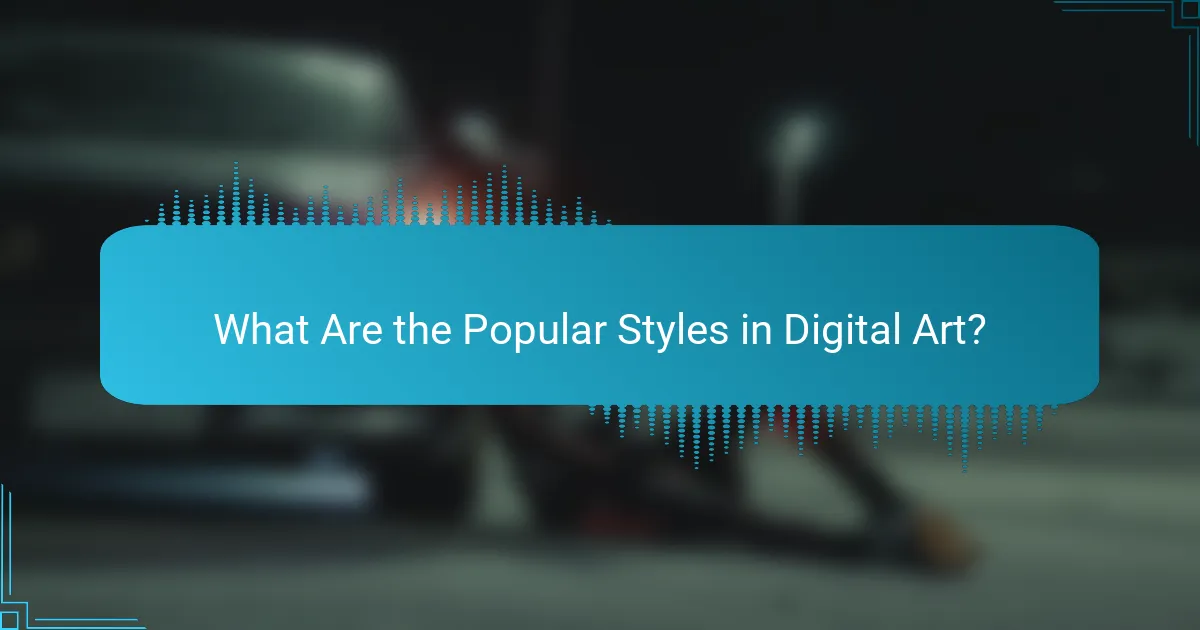
What Are the Popular Styles in Digital Art?
Popular styles in digital art reflect diverse aesthetics and techniques that artists use to express their creativity. These styles often incorporate modern technology and cultural influences, resulting in unique visual experiences.
Vaporwave Aesthetic
The vaporwave aesthetic is characterized by its nostalgic and surreal visuals, often featuring retro graphics, glitch art, and a pastel color palette. This style draws heavily from 1980s and 1990s pop culture, incorporating elements like old internet graphics and consumerism themes.
Artists working in this style often use software tools to manipulate images and create dreamlike environments. Common techniques include layering images, using 3D rendering, and applying filters that evoke a sense of nostalgia.
Minimalism in Digital Design
Minimalism in digital design emphasizes simplicity and functionality, focusing on clean lines, limited color palettes, and ample white space. This style aims to convey messages clearly without unnecessary embellishments, making it popular in user interface design and branding.
When creating minimalist designs, consider using a few key elements to communicate your idea effectively. Avoid clutter and prioritize essential features, ensuring that each component serves a purpose. This approach can enhance user experience and improve visual appeal.
Cyberpunk Influences
Cyberpunk influences in digital art often depict futuristic, dystopian themes characterized by high-tech and low-life scenarios. This style combines neon colors, urban landscapes, and elements of science fiction to create a visually striking atmosphere.
Artists inspired by cyberpunk frequently explore themes of technology, society, and identity. Incorporating elements like augmented reality or digital glitches can enhance the cyberpunk feel. When creating art in this style, consider blending traditional techniques with digital tools to achieve a unique look.
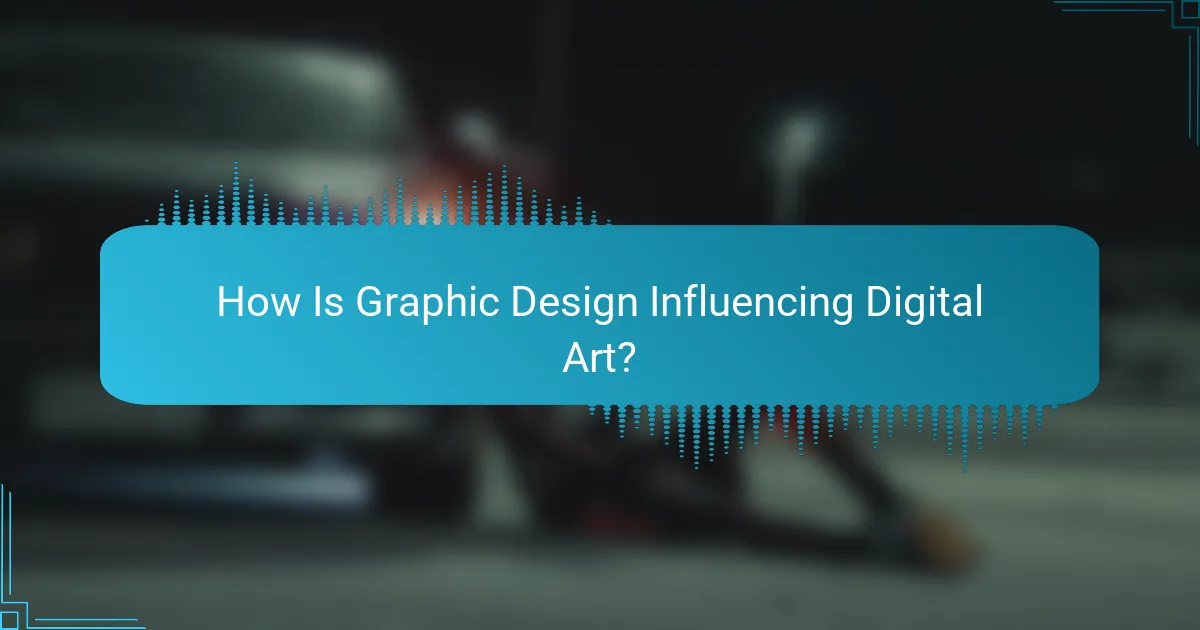
How Is Graphic Design Influencing Digital Art?
Graphic design significantly shapes digital art by introducing innovative techniques and visual communication strategies. As artists adopt design principles, they create more engaging and cohesive works that resonate with audiences across various platforms.
Cross-Pollination of Techniques
The blending of graphic design and digital art techniques fosters creativity and innovation. Artists often incorporate elements such as typography, layout, and color theory from graphic design into their digital creations, resulting in unique styles that stand out in the crowded digital landscape.
For example, a digital artist might use graphic design principles to create a visually striking poster that combines illustration with text, enhancing the overall message. This cross-pollination encourages experimentation and helps artists push the boundaries of their work.
Branding and Visual Identity Trends
Graphic design plays a crucial role in shaping branding and visual identity within digital art. Artists are increasingly aware of how their work contributes to brand narratives, leading to more strategic choices in color palettes, typography, and imagery.
For instance, a digital artist creating content for a tech company may adopt a sleek, modern aesthetic that aligns with the brand’s identity. This alignment not only strengthens the brand’s visual presence but also enhances the artist’s portfolio, making it more appealing to potential clients.

What Impact Do NFTs Have on Digital Art?
NFTs, or non-fungible tokens, have transformed the digital art landscape by providing artists with new ways to monetize their work. They enable unique ownership and provenance, allowing creators to sell their art directly to collectors without intermediaries.
New Revenue Streams for Artists
NFTs open up innovative revenue opportunities for artists by allowing them to sell their digital creations as unique assets. This can include everything from digital paintings to music and video art, with prices often ranging from hundreds to millions of dollars depending on the artist’s reputation and the work’s uniqueness.
Artists can also benefit from royalties on secondary sales, meaning they earn a percentage every time their artwork is resold. This ongoing income stream can significantly enhance an artist’s financial stability compared to traditional sales methods.
